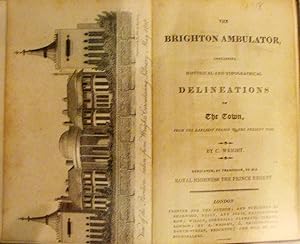About this Item
FIRST AND ONLY EDITION. 12mo, 171 x 103 mms., pp. xii, 179 [180 addenda], engraved frontispiece of Pavilion (dated May 1818, engraved by R. Alford), two other full-page engraved plates (all plates a little browned), contemporary half calf, gilt spine, marbled boards; front joint rubbed, corners very slightly worn, but a very good copy, with the inscription on the recto of the front free end-paper, "W. H. [?Blaber]/ 22 December 1925/ from/ B. Watson." Among the other interesting features of Brighton in the Regency period that Wright describes if that of a "fly," a small carriage drawn by one horse, and as the Brighton Museum notes, "Flys were the cause of some debate in the early nineteenth century mostly due to being numerous and because of complaints about variable rates, and so the town Commissioners, the local authority of the day, issued a table of fares and started to regulate them. They could be described as the Regency equivalent to the mini-cab, and were particularly popular in the busy seaside resort of Brighton, and may even have originated here. The difference to a normal coach or hansom cab was that they were pulled and pushed by manpower rather than horses." Wright also describes in some detail the "steam kitchen" as an "admirable specimen of mechanical innovation" and a culinary phenomenon in which one can find "every modern improvement to facilitate the process of the culinary art." No wonder the then Prince Regent, who would become George IV in 1820, weighed about 130 kg., and as one observer noted, "'What do you think of his breakfast?' wrote this astounded witness. 'Two pigeons and three beefsteaks, three parts of a bottle of Mozelle, a glass of dry Champagne, two glasses of Port and a glass of Brandy.'" Uncommon. I located copies in BL, City of London Guildhall Library, Brighton University (Falmer); Yale, Princeton, Library of Congress. Seller Inventory # 8717
Contact seller
Report this item
![]()

